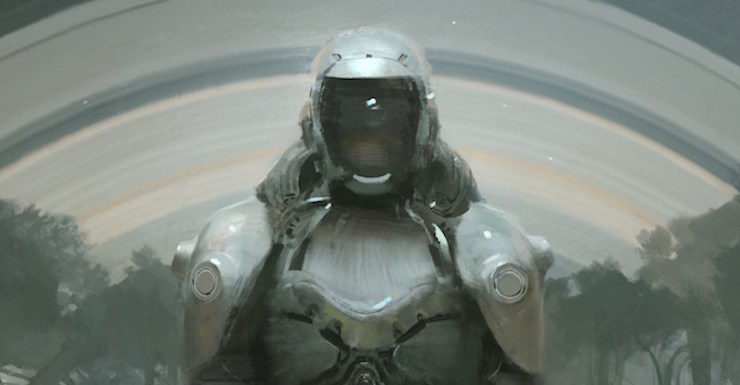I was tearing up at the end of All Systems Red, and I wasn’t sure why. Yes, it was sad that Murderbot was leaving its friends and colleagues, and a promised life of safety, behind. But there was something more, something to do with the entire arc of Murderbot’s journey from a SecUnit—seen more or less as a lethal appliance—to a trusted and capable member of a team of humans.
For me as a trans woman, All Systems Red’s concoction of heartbreak and ever-present anxiety felt achingly familiar to me (even as Murderbot’s narration and dry delivery cracked me up more often than not), as I looked back at various pressure points in my own transition. The novella has a lot to say about building a personal identity on the fly.
“Nevermind what you ‘want’—what do you really want?”
When you’re a Murderbot who’s disabled your Governor Module and you’ve achieved full sentience—sorry, I meant “came out to yourself as trans”—the first thing you need to do is figure out the gap between what you really want and what you’re supposed to want. This can take some time, and doesn’t follow a straight (really, Anya?) path.
In other words, where does this desire come from, and how much is it mitigated or amplified by what the people around you want?
“Mitigated” can, of course, mean “absolutely turn into a train wreck.”
Let’s check in with Murderbot about this crucial issue:
It’s wrong to think of a construct as half bot, half human. It makes it sound like the halves are discrete, like the bot half should want to obey orders and do its job and the human half should want to protect itself and get the hell out of here. As opposed to the reality, which was that I was one whole confused entity, with no idea what I wanted to do. What I should do. What I needed to do.
This confusion—being a confused entity—can be off-putting to other people. But the important thing is that confusion is on your timetable. And it’s not because of some inherently fragmentary or illusory sense of identity but simply giving yourself the time, for once in your life, to get your act together.
How to build the airplane (or planetary skimmer) and fly it at the same time.
There’s a period in many trans people’s transition that’s like the “transition inside of a transition.” (Because you’re almost always in transition. It never stops.) There are a lot of moving pieces at once, but also you have to, well, live your life. Like when the identity you’re trying to claim doesn’t quite match your legal documentation. Or when you’re in this limbo between being SecUnit and Murderbot:
Then she added, “You know, you can stay here in the crew area if you want. Would you like that?”
They all looked at me, most of them smiling. One disadvantage in wearing the armor is that I get used to opaquing the faceplate. I’m out of practice at controlling my expression. Right now I’m pretty sure it was somewhere in the region of stunned horror, or maybe appalled horror.
Buy the Book


All Systems Red: The Murderbot Diaries
Murderbot has existed for a long duration purely in service to humans. And for a long time after disabling its Governor Module, it still pretends it’s a robot. It goes through the motions of robot-ness—just to be left alone, more than anything else. Even when the humans it’s been assigned to know that it’s sentient, sometimes it does everything it can to mitigate the stress and shock of this.
And sometimes, it just doesn’t care. That’s what makes this story ring true in so many places. Murderbot doesn’t care about your human b.s. More than anything, it doesn’t care about human curiosity about a sentient Murderbot, even if the human being has the best intentions in the world.
That’s what makes the narration so rich and pitch-perfect: rarely in stories are we shown the need for downtime when you are presenting in a new identity for the first time, shown that social recuperation is just as important as the physical.
But of course, we all need that.
The Joy of Sentience: Squeezing in as much Space Netflix as (in)humanly possible.
You think I’m being flippant? Murderbot watches a lot of Space Netflix (and listens to a lot of Space Spotify, etc. etc.)—it brought over 35,000 hours’ worth. It’s Murderbot’s access to human culture, and the humans are rather surprised to learn this. That on missions, Murderbot is actually using the com channels to squeeze in more Space Netflix. The augmented human in the group, the one most adversarial to Murderbot, accuses Murderbot of hiding encoded messages in the entertainment feed—but the genius of All Systems Red is that the very thought of this is ridiculous. We know Murderbot at this point. It just wants to watch its stories.
Allies: Can’t live with them and, well…
The best—and I’d argue the most insightful—part about All Systems Red isn’t really about Murderbot at all, but rather how the people around Murderbot react to having a sentient Murderbot in their midst, with its own notions of agency. Rather than having a collective existential freak-out, they more or less accept Murderbot into their fold and try to make things as comfortable as possible for it. They rarely make the story about themselves and overanalyze their own reaction to having a Murderbot colleague, or work hard to give themselves “ally cookies” for Not Being Horrible and Cruel. Even the aforementioned augmented human in the group, who is the most adversarial towards Murderbot, doesn’t try to deny Murderbot the story it tells about itself, or be an asshole about its identity:
“I do think of it as a person,” Gurathin said. “An angry, heavily armed person who has no reason to trust us.”
When Gurathin pushes Murderbot about why it doesn’t want to look at humans while talking (and as Murderbot observes: not a great idea to piss off a Murderbot!), more than one human comes to its defense.
My jaw was so tight it triggered a performance reliability alert in my feed. I said, “You don’t need to look at me. I’m not a sexbot.”
Ratthi made a noise, half sigh, half snort of exasperation. It wasn’t directed at me. He said, “Gurathin, I told you. It’s shy.”
Overse added, “It doesn’t want to interact with humans. And why should it? You know how constructs are treated, especially in corporate-political environments.
Which doesn’t mean, as the end of the last passage might indicate, that the situation is comfortable for Murderbot. Oh no, far from it. Even good allies will still talk amongst themselves about the socio-political implications of you existing. (Even the awesomest friends or loved ones can screw up your pronouns.) But even Murderbot recognizes that it more or less lucked out by being put with this group rather than one that’s more hair-trigger (literally and figuratively). And yet…
Sometimes, even the best allies might not be enough.
Sometimes the best way to get through a situation is to be alone, or find your own way forward, no matter how hard that might be. Or else to find pockets of solitude that you can fold into. This is one of the hardest truths of All Systems Red. Murderbot saw the life in front of it with the Preservation humans, who have been nothing but kind, but finds itself disappointed:
I’d have to pretend to be an augmented human, and that would be a strain. I’d have to change, make myself do things I didn’t want to do. Like talk to humans like I was one of them. I’d have to leave the armor behind.
But maybe I wouldn’t need it anymore.
So it finds a bot-driven cargo transport who also likes to watch Space Netflix, and slips away. Of course this departure hearkens back to much older tropes from Westerns (or, you know, Mary Poppins), when the lone gunslinger is unwilling or unable to take part in Reasonable Society and must ride off alone (maybe this is something that Murderbot learned while watching Space Netflix). But it’s especially poignant in terms of Murderbot, because its identity is so new.
And yet—you have to remember that this isn’t the end of the story, but only the beginning. When the “transition inside the transition” ends, you can spend less energy modulating your responses and expressions for other people and just be yourself.
Even when alone, we can be together.
Murderbot isn’t heartless. The whole novella, as it’s revealed in the last lines, is an epistle to Dr. Mensah, its “favorite human.” This diary segment—of which All Systems Red is blessedly only the first part—is an attempt at connection, without being a justification or apology. Even when you feel alone, even when the people on the other end aren’t going to fully understand, sometimes you just have to write it all down, in order to save yourself.

The Murderbot Diaries—All Systems Red, Artificial Condition, Rogue Protocol, and Exit Strategy—is available from Tor.com Publishing
Originally published in March 2018.
Anya Johanna DeNiro writes, among many other things, YA novels about the adventures of young trans women. She also recently released A Bathroom Myth, a pay what you want Twine game as a fundraiser for the Transgender Law Center. For the most part, she can be found online at Twitter @adeniro.










